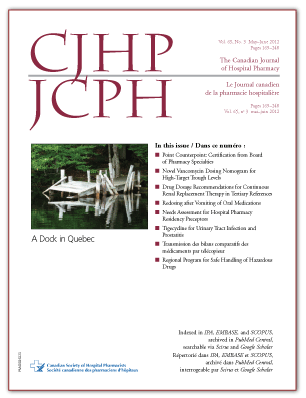Development and Validation of a Novel Vancomycin Dosing Nomogram for Achieving High-Target Trough Levels at 2 Canadian Teaching Hospitals
DOI:
https://doi.org/10.4212/cjhp.v65i3.1140Keywords:
vancomycin, therapeutic drug monitoring, nomograms, vancomycine, suivi thérapeutique pharmacologique, nomogrammesAbstract
ABSTRACT
Background: Recent guidelines recommend a vancomycin trough (predose) level between 15 and 20 mg/L in the treatment of invasive gram-positive infections, but most initial dosing nomograms are designed to achieve lower targets (5–15 mg/L). Clinicians need guidance about appropriate initial dosing to achieve the higher target.
Objective: To develop and validate a high-target vancomycin dosing nomogram to achieve trough levels of 15–20 mg/L.
Methods: A retrospective study was conducted at 2 teaching hospitals, St Paul’s Hospital and Vancouver General Hospital in Vancouver, British Columbia. Patients who were treated with vancomycin between January 2008 and June 2010 and who had achieved a trough level of 14.5–20.5 mg/L were identified. Demographic and clinical data were collected. Multiple linear regression was used to develop a vancomycin dosing nomogram for each hospital site. An integrated nomogram was constructed by merging the data from the 2 hospitals. A unique set of patients at each institution was used for validating their respective nomograms and a pooled group of patients for validating the integrated nomogram. Predictive success was evaluated, and a nomogram was deemed significantly different from another nomogram if p < 0.05 via “X2 testing.
Results: Data from 78 patients at one hospital and 91 patients at the other were used in developing the respective institutional nomograms. For each hospital’s data set, both age and initial serum creatinine were significantly associated with the predicted dosing interval (p < 0.001). Validation in a total of 105 test patients showed that the integrated nomogram had a predictive success rate of 56%.
Conclusions: A novel vancomycin dosing nomogram was developed and validated at 2 Canadian teaching hospitals. This integrated nomogram is a tool that clinicians can use in selecting appropriate initial vancomycin regimens on the basis of age and serum creatinine, to achieve high-target levels of 15–20 mg/L. The nomogram should not replace clinical judgment for patients with unstable and/or reduced renal function.
RÉSUMÉ
Contexte : Des lignes directrices récentes recommandent des concentrations minimales (prédose) entre 15 et 20 mg/L pour le traitement des infections envahissantes à bactéries Gram-positif, mais la plupart des nomogrammes pour la posologie initiale sont conçus pour obtenir des concentrations cibles plus faibles (entre 5 et 15 mg/L). Les cliniciens ont besoin de conseils pour établir la posologie initiale appropriée permettant d'atteindre des concentrations cibles plus élevées.
Objectif : Développer et valider un nomogramme posologique ciblant des concentrations minimales élevées entre 15 et 20 mg/L.
Méthodes : Une étude rétrospective a été menée dans deux hôpitaux universitaires de Vancouver (Colombie-Britannique), l’Hôpital St. Paul et l’Hôpital général de Vancouver. Les patients traités par la vancomycine entre janvier 2008 et juin 2010 chez qui on a obtenu des concentrations minimales se situant entre 14,5 et 20,5 mg/L ont été recensés. Les données démographiques et cliniques ont été collectées. Une analyse de regression linéaire multiple a servi à développer un nomogramme posologique pour la vancomycine à chaque hôpital. Un nomogramme intégré a été construit en fusionnant les données des deux hôpitaux. Une série unique de patients à chaque hôpital a servi à valider leur nomogramme respectif; un groupe combiné de patients, le nomogramme intégré. La réussite révisionnelle a été évaluée et un nomogramme était jugé comme étant significativement différent d’un autre si p < 0,05 d’après le test du chi carré.
Résultats : Les données de 78 patients dans l’un des hôpitaux et de 91 patients dans l’autre ont été utilisées pour développer leurs nomogrammes respectifs. Pour l’ensemble de données de chaque hôpital, l’âge et la créatininémie étaient tous deux des variables prédictives significatives de l’intervalle posologique (p < 0,001). La validation chez un total de 105 patients expérimentaux a montré que le nomogramme intégré avait un taux de réussite prévisionnel de 56 %.
Conclusions : Un nomogramme posologique novateur pour la vancomycine a été développé et validé dans deux hôpitaux universitaires canadiens. Ce nomogramme intégré aidera les cliniciens à choisir les posologies initiales de vancomycine en tenant compte de l’âge et de la créatininémie, afin d’atteindre les concentrations cibles élevées de 15 à 20 mg/L. Le nomogramme ne doit pas remplacer le jugement du clinician chez les patients dont la fonction rénale est instable ou réduite.
Downloads
Published
Issue
Section
License
Copyright © Canadian Society of Healthcare-Systems Pharmacy.
After publication of a manuscript in the CJHP, the authors of the manuscript must obtain written permission from the CSHP (publications@cshp.ca) before reproducing any text, figures, tables, or illustrations from the work in future works of their own. If a submitted manuscript is declined for publication in the CJHP, all said rights shall revert to the authors. Please note that any forms (e.g., preprinted orders and patient intake forms) used by a specific hospital or other health care facility and included as illustrative material with a manuscript are exempt from this copyright transfer. The CJHP will require a letter from the hospital or health care facility granting permission to publish the document(s).










